blog
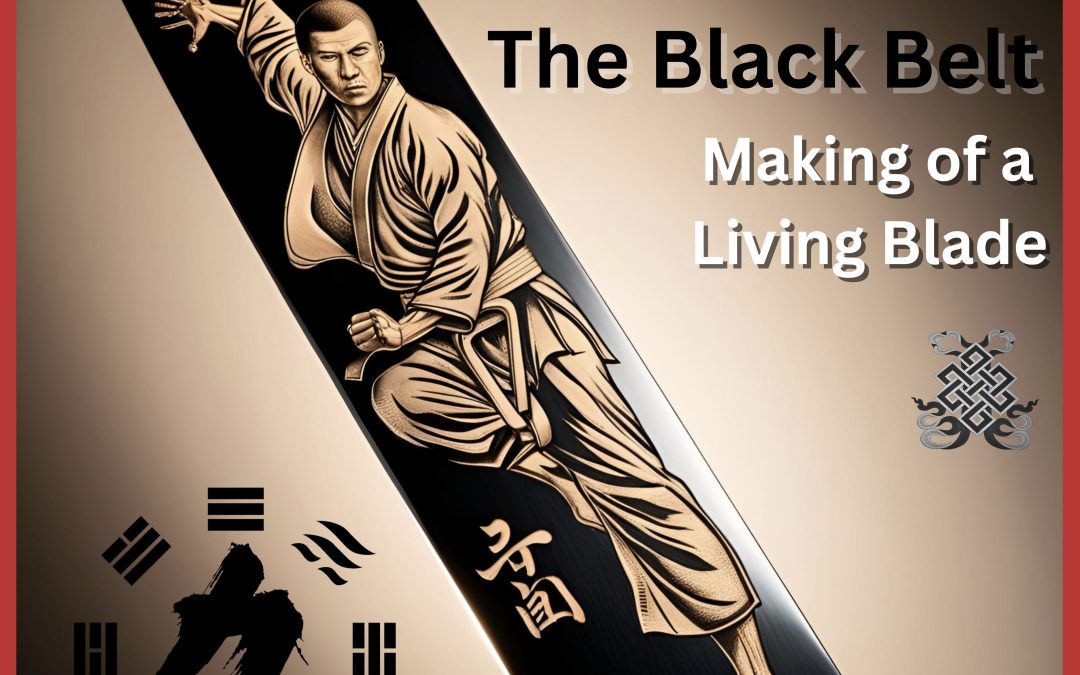
The Black Belt: Making of a Living Blade
A Japanese swordsmith will tell you that no two crafted blades are the same. Likewise, no two karate black belts ever turn out with identical skills. Look at your family, if you are a sibling, or have siblings of your own, are they identical? Parents can birth wildly different offspring. So it goes in the martial arts. Each new Shodan is a unique living blade, forged in the cooperative sweat and commitment of the sensei and disciple to ensure the lineage passes on. What is this lineage? The instructor’s belief in what makes a black belt. No two sensei will produce the same living blade. We may share common ideologies and techniques but our work is as distinctive as our fingerprints.
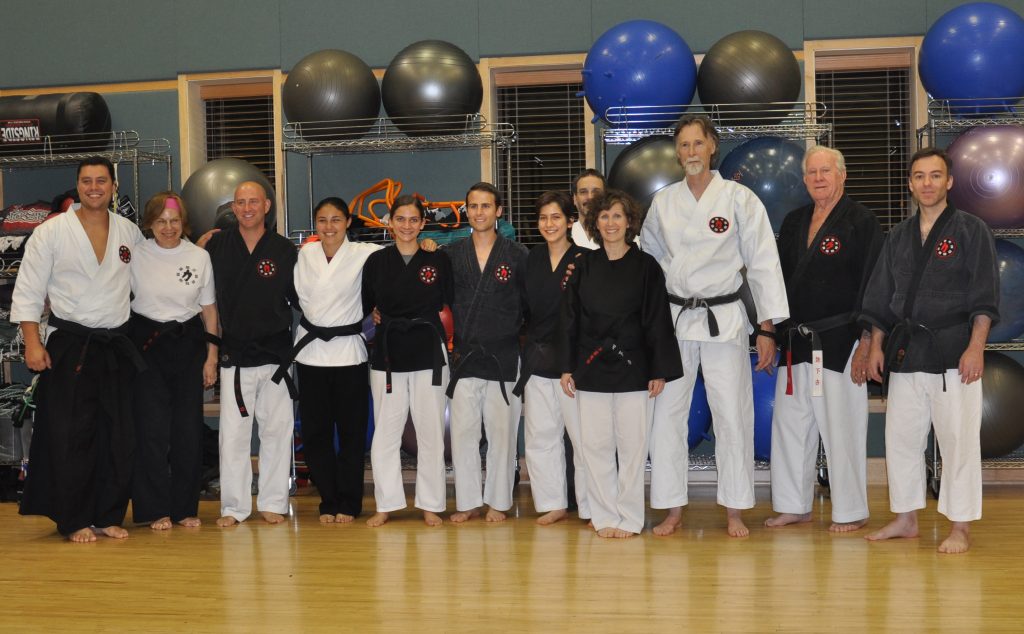
Black Belts at the Chatham Club, 2012
As significant it is for the kyudansha’s (colored belt) ascent through the belt ranking system to reach the coveted Kuro Obi, few stop to consider that this accomplishment would never have happened if one’s teacher had slacked off in the process. Every sensei is tasked with the art of abiding to his blade-making. He must direct the student’s mindset, properly pace the training, introduce layers of new material, correct and challenge where necessary. This process is often fraught with unexpected twists and turns. There’s the student who one day just disappears after years of mutual sweat and tears. Or the unfortunate dojo misunderstanding or accident that sharply terminates the dojo relationship. A disciple can lose interest, fall in love, no longer afford training, get sidelined by injury, hit a wall of boredom, unsurety or confidence. The wise sensei must intervene with the right remedy to remove the obstruction(s), or all is for naught.
The average time to craft a black belt in our dojo is a minimum of 5-7 years, attending class 2/3 times a week consistently, along with training on one’s own where one can. Of course, there are exceptions, depending upon what one brings to the table from prior experiences. The U.S. Special Forces medic did it under two years. Others spread it out over decades. I remember doing a survey after a mother of a 10-year-old boy complained that all the other children in the class had been promoted before her son. She was wrong. She didn’t understand to each his or her own pacing. It’s not a competition. It is a journey and everyone’s path is deeply personal.
For a student to succeed they must trust in the process. It works. I don’t think a single black belt has ever regretted their journey.
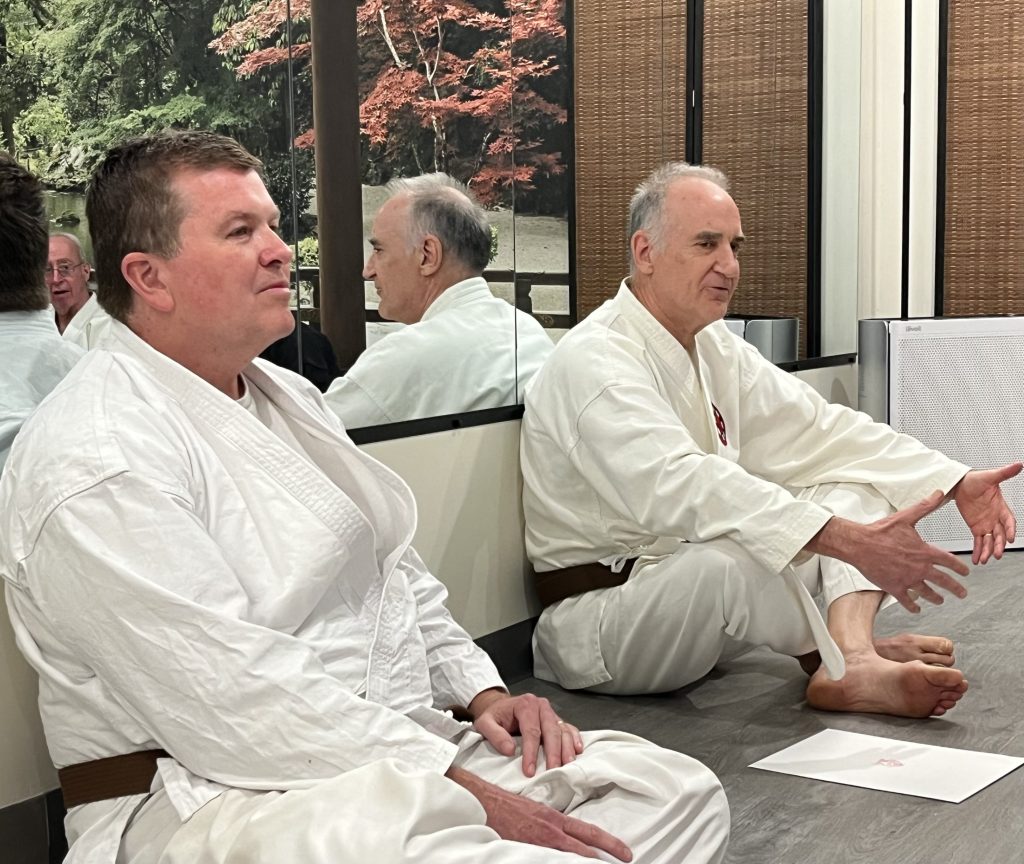
At the Fireball Throwing seminar in Florham Park on March 24th, Bob Tighe, lft. and Carlo Bracco, rgt. received their Shodan Black Belt ranking. Later, the newly appointed each burned a white origami crane, representing the end of the old and beginning of their new journey as yudansha.
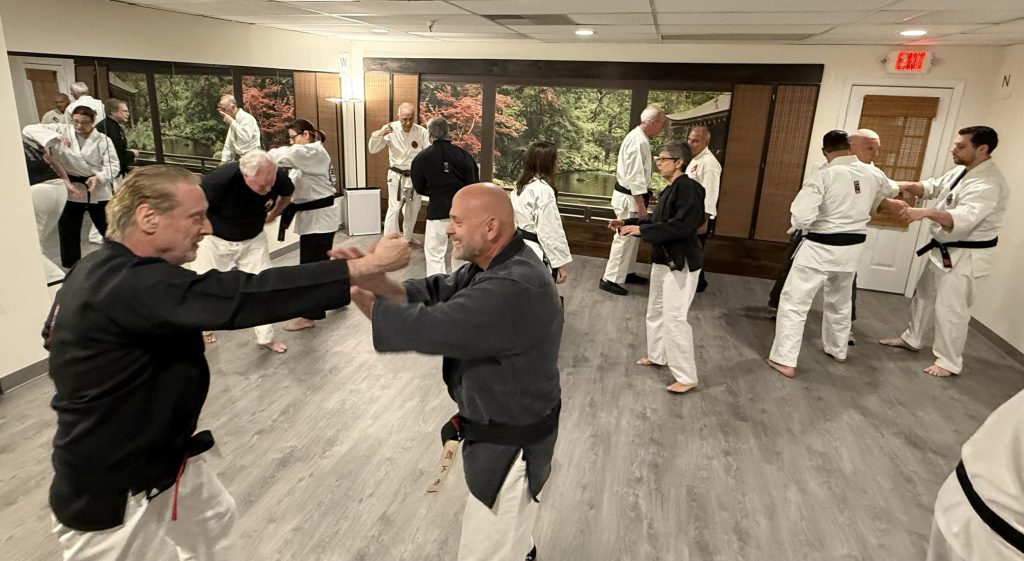
The seminars are going well. The enthusiasm has been high.
Through an arrangement via Jay Austin, I had a lengthy conversation with noted isshinryu Sensei Mike Calandra (isshinryu), who currently lives in Arizona. I was curious to what degree Sensei Calandra might be familiar with Kiko principles. Sensei Calandra has invited me on his Martial Truth podcast, to discuss the topic. The date is pending.
My Middle Grade novel, Star Quest Sensei and the Flying S is done! Now comes the hard task of finding a publisher. If you have any thoughts, let me know.
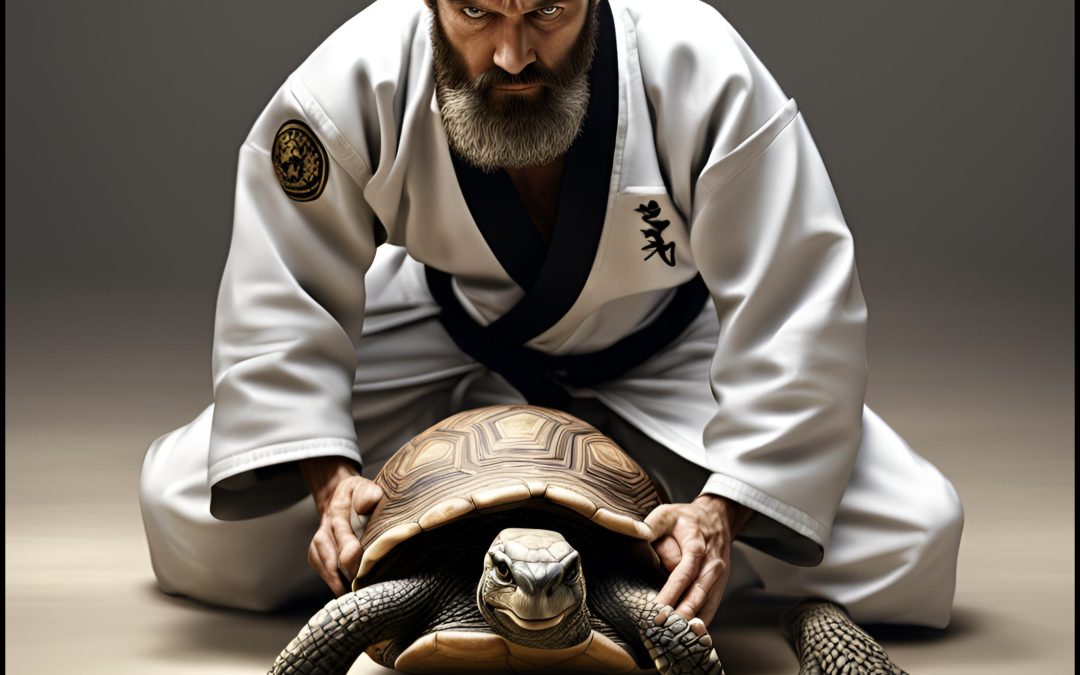
Slow & Steady Intensity
I’ve witnessed a lot of changes since my formal introduction to Okinawan karate in 1968. 2024 marks my 56th year in the arts—53 as a professional teacher. Even more dramatic, have been the changes in the world since then. Life has become frenetic for most. The trend being, ‘Do it all, and hurry up!’ Perhaps, this is why anxiety has striken such large swaths of society. Even our arts are having to adjust to the world’s wild gyrations. For example, a lot of schools took a big hit during the pandemic.
Regardless, I prefer to drink my tea slowly, because I was born in an era where the pace of life was easier and people were generally positive and accomodating, a healthy way to be.
I have no desire to hurry up and produce. Liken it to a farmer saying to his plants, ‘hurry up and grow.’ It’s not natural. Okay, there is a small part of me that would like to do weekly blogs and increase my social networking presence, but that’s a cultural stick poking me from behind. Rushing has never sat well with me.
I would however, like to share what I have been up to lately. Teaching remains steady and productive. Thanks to a devoted group of yudansha we continue to make extraordinary inroads into the internal nature of the traditional, form-based disciplines, which are all interlinked through common principles.

LITERARY KUMITE
Somtime soon, no later than the end of June, 2024, I will be releasing my latest book on Kiko, a 400 page, 190 image, deep dive into the internal principles embedded in traditional martial arts. This book was a labor of love that gained full steam during the pandemic.
In March a serendipitious event tasked me with the creation of an entire Special Edition of Masters Magazine, published out of California, which should also be released in late June. I was offered the editorship and cover appearance along with two feature articles. I corralled a dozen or so expert contributors who cover such topics as; the origins of the Dojo, monastic martial science, the early days of Okinawan karate on American soil, the vanishing art of ‘effortless’ power, and more.
Further in the literary arena I believe is the nearing completition of a book on the life of a former student, Harvey Schwartz. Harvey was an exceptional martial artist who went on to became a captain of industry as CFO of Goldman Sachs and currently as CEO of the Carlyle Group. His book will include an entire chapter on his martial experiences training with me in the 90’s.
I must also mention, Kate Marshall in Australia, who has done extraordinary research on the sacred currents running thorugh most of our traditional arts. Her book, presently pending release, is entitled; Sacred Arts Martial Arts, a must for any serious martial practitioner. And of course, I should mention the editing flare of the Inner Kata Queen,
who as I write, is tidying up my Middle Grade novel, Sensei & The Flying ‘S’, an epic martial mystery, sure to jangle the brains of daring readers. It’s a zany story that needed airing.
I take my time—slow and steady. Those who know me, know I favor the tortoise.
I never said I don’t get things done.
*The expression ‘slow and steady wins the race’ comes from the fable written by Aesop in the 500s B.C. of the race between the Tortoise and the Hare.
Readers wishing for release dates about the books and magazine can contact me at windschool@earthlink.net to be added to a notification list.
Seiuchin Kata Bunkai: Devils in the Detail
If you’ve watched the Seiuchin Kata Bunkai video, you’ve gotten the technical skinny for applying a double joint lock against several straightforward attacks. However, in the video, I only presented the form’s overt technicalities, not the covert ones. The sub-rationale explains why the moves are done in the exacting manner shown. Lying beneath the surface action of any kata is a subflooring of internal formulas revealing a dynamic clash of Biofield energies.
Isshin Kempo Versus Isshinryu:
The video sequence performed is from the Isshin Kempo system, a close relative to Isshinryu with some key differences. We consider Isshin Kempo to be Isshinryu’s internal sister art, which is why those familiar with the Isshinryu variant of Seiuchin kata may notice some technical nuances to the moves demonstrated. I believe Isshinryu was not passed along with its bunkai clearly established. A lively debate could be started around several questions; what constitutes practical bunkai and was isshinryu’s founder aware of Kiko (internal) principles in his own kata? No one seems to have a clear historical grasp on this point.
Breathing:
In all the best constructed Forms, breathing is never random. Every move is breath specific. When the breath is properly aligned with the Form, you will find a significant uptick in strength. The four-move Seiuchin sequence in the video follow precise respiratory patterns; Breathe out on the first retreating Seiuchin step. Breathe in on the second retreating Seiuchin step. Breathe out on the right knee strike. Breathe in when concluding the double joint lock while slip-stepping into Seisan dachi.
Stance:
The initial retreat functions best with the left leg falling back into a Seiuchin dachi as opposed to a Kiba Dachi. This posture, with its large, distinct arm motions, creates a strong energy draw. That is, you will be drawing a charge off the opponent leaving them physically weaker for your counter with the double locks. This is why I stress in the video that you must not move your rising left arm to the inside of the attacker’s arms. Neither the Horse stance, nor a right foot retreat, will draw the same strong charge from the opponent. Incorrect actions will result in a drop in your own energy field, leading to physical weakness. Kiko results are not obvious until strong attacks or resistance to your defense is given, or you conduct strength tests after concluding these actions. There are five layers to consider in all kata work:
- Making sure each of your selected tools is optimal, or in the optimal position.
- Selecting the correct tactics, which the kata provides in its sequencing.
- Selecting the correct strategy, which, in this case, is to lead the attacker into an ever-weakening internal state.
- Selecting the correct state of mind, which is to dominate the attack.
- Applying Kiko, to control the fundamental energy currents alongside your natural talents and strengths.
Second Wind: Greetings for the New Year
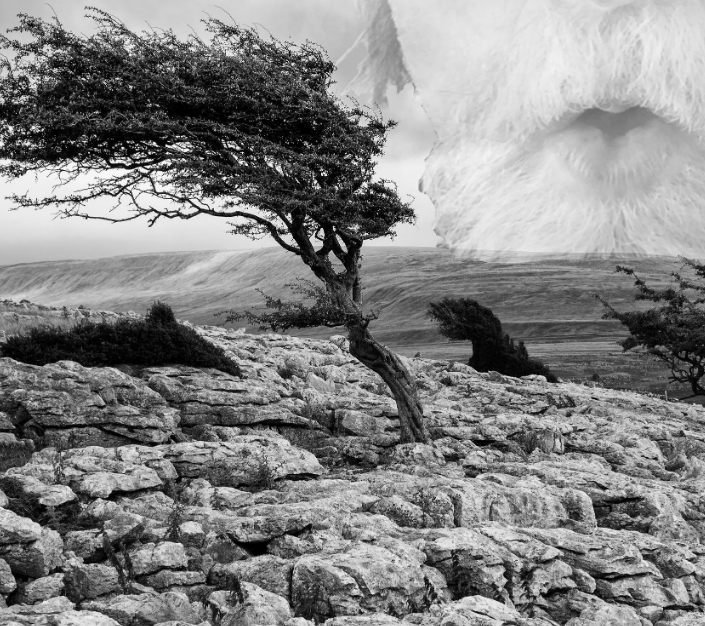
What a mental roller coaster this last year and a half has been with Covid challenging our personal, social and economic terrain. I hope you are all doing well under these circumstances.
I know some of you have not been able to train with me for a variety of reasons. I’m hoping to reignite your spark. A core group has kept up their practice throughout the pandemic with my offerings of virtual and live training.
I thought you might like a brief overview of what’s been happening at the Wind School since the pandemic. My health has been exceptionally good, maybe because I am not teaching hordes of children anymore. The downtime from the group classes has also given me a lot of free time to explore my second passion—writing about martial arts.
There’s been lots of action on the creative/literary side. I finished a 290 page Middle Grade mystery novel, The Flying ‘S’. If any of you have any publishing contacts, I am all ears. I’ve also got several articles in the pipeline. I am not the only Wind Warrior on a literary tear. The former black belt, Harvey Schwartz, signed a book deal with Simon & Schuster to publish his memoirs. There will be a major chapter devoted to his martial arts training with me thirty years ago. I met with Harvey and his ghostwriter mid-December in an interview to rehash those dynamic times.
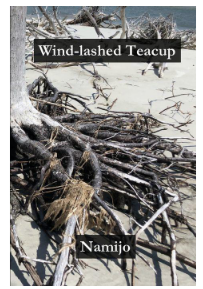
Amanda Lyons published her second poetry book, The Wind-lashed Teacup, under her pseudonym, Namijo.
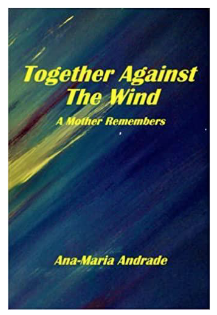
Roberto’s mother published a book about her daughter, Patricia’s, years long bout with an unknown illness. Patricia earned her green belt in karate back in 1993. She may have been the impetus for Roberto’s early training. The book, Together Against the Wind: A Mother Remembers is also in Spanish, Juntas Contra El Viento: Memorias de una Madre. Available on Amazon: Together Against the Wind

(Sonya in the purple shirt on right Chatham Club, 2009)
Former student, Aikido black belt, Sonya Haramis, recently released her new spiritual album, Return of The Soul. See link: www.peaceofthedreamer.com Sonya’s music can be found here.
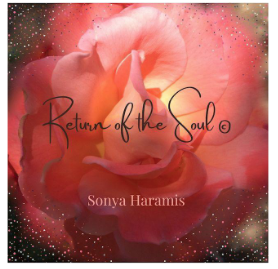
My brother Colin, the Poetorialist, gives live, stimulating, fireside poetry readings on Youtube every Wednesday evening. Check out his playlist at: Floating Poetry Broadcasts – YouTube or visit his site at www.thepoetorialist.com
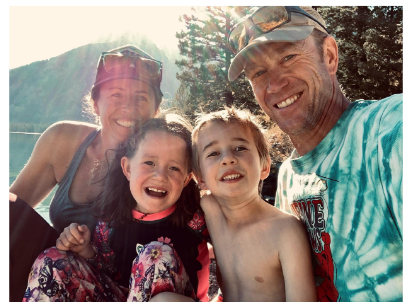
Allison, Alexis, Dillon, Nick
Sensei Nick Armitage, Wyoming, is teaching his two kids, Lexi (7) and Dillon(5) Karate. Nick has also been training for over two years at a local jiu jitsu gym. Nick is a Park Ranger. His duties include: Search and Rescue, Law Enforcement, Emergency Medicine, Structure and Wildland Fire.
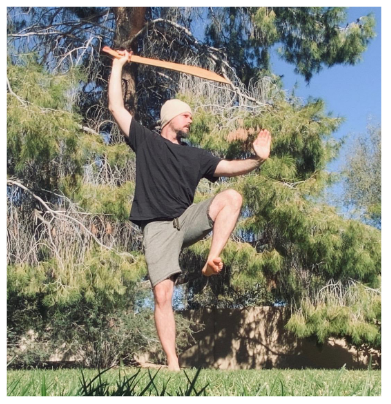
Sensei Tom Maloney is now living and training on his own in Scottsdale, Arizona. He moved out of Morristown into his new condo in November of 2021. Tom is spending time with family, being outdoors and learning Seven Star Saber. He created two martial strength training programs; Stone Immortal and Earth Immortal. He’s currently looking for a place to teach in the new year.
Sensei Brian Vivas recently landed an excellent job with the noted Boston Based Data Science software company, R Studio. He is happily working remotely in Summit at his apartment.
Senior black belt, Joe Noonan, 83, is doing well. He still works out daily in his home dojo. Joe says hello to everyone. Eric says he maintains a daily practice of a minimum of twenty kata each day, often outdoors.
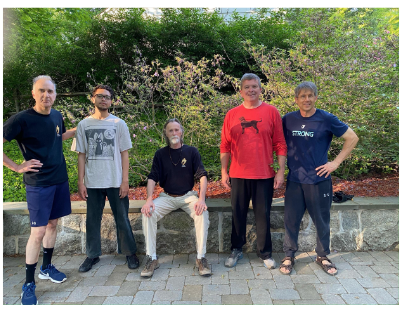
Carlo, Brian, Shifu, Bob, Pete
Carlo and Bob teamed up over a year ago and have been enjoying weekly class working on their Sunsu kata and Kusanku applications. Their advancement roused Pete Meienhofer, currently living in Cary, North Carolina, to get back into training.
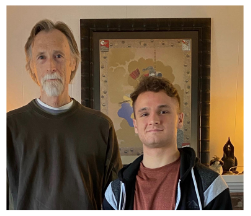
PJ stopped by over the Holidays en route with his parents to a vacation in Mexico. His maritime schooling is going well. He spent 134 days at sea and got to visit Spain and Portugal. He plans to join the Navy when he graduates next year as Ensign, PJ Milich.
Jordan Dickman, a former teenage student at the Madison YMCA earned his Sankyu, 3rd degree brown belt at the end of the ‘2. Jordan, a junior Morristown High, is hoping to clinch his black belt before graduation.
Amanda Lyons is working down in Wildwood, NJ. She’ll be studying horseshoe crabs this year, a switch from turtles. She manages to get in a virtual private most weeks as does Wendy and her son, Dan.
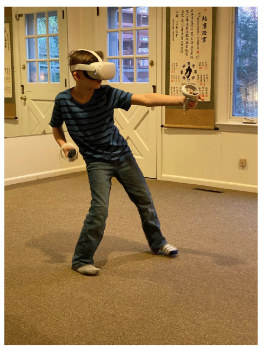
My grandson, Mason, in the dojo playing Pistol Whip
Tom Lyons gives us a fun at home training tip. Try out the new Oculus Quest 2 Virtual Reality game, Thrill Of The Fight. Step into an amazing 3D world and slug it out with increasingly tougher opponents. It’s a three round work out.
OUCH!
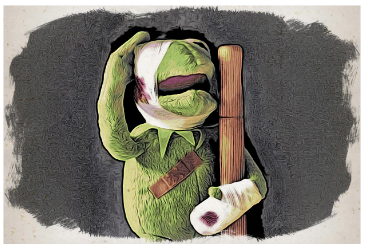
Senior black belt, Jay Austin, came down with a serious case of Covid after the holidays. It was touch and go for 72 hours. When he began to have troublebreathing he drove to the hospital where he was diagnosed with Covid pneumonia in both lungs and immediately admitted. Luckily, he had a connection with the top doctor at Jersey Shore Hospital. Jay is through the worst of it. He was discharged after a nine-day hospital stay. He credits his martial arts for giving him the strength to fight through the illness.
Judy Keays got into a fight with her kitchen requiring four stitches. The kitchen won this round but she threatens revenge on the plateware when the time is right.
Sandan, John Kralovenec, in upstate NY, might hold the record as the Wind School’s most Bionic Man as he swops out old body parts for new. He’s scheduled for another knee operation in February.
Tune up with a visit to Roberto’s acupuncture clinic in Florham Park to reduce your chances of getting Covid or the flu.
http://www.naturalintegratedmedicine.com/home/about-roberto
Many current students are happy to reduce their class fee by having others join them. Feel free to ask me for list of names of active students. Then reach out to anyone you’d like to practice with.
Wishing you all the best for this unfolding year! Stay Strong. Stay Alert. Stay Healthy!
My best to all,
Hayashi
William Scott Russell
The Bank Street School, where I received my early training, was one of New Jersey’s pioneering dojos. Out of this school emerged William Scott Russell and the birth of his system, Isshin Kempo. Most people are not aware of how Russell came about his sokeship of Isshin Kempo. Here is a that story.
……………………………..
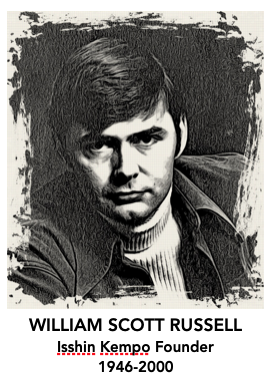 William Scott Russell was my most influential teacher in the early 1970’s. He was a dynamic, articulate, charismatic and, for some, controversial figure. Russell drew over a thousand students into the richness and allure of Okinawan karate in the North Central New Jersey region at the Bank Street Dojo where he taught from 1970-1982.
William Scott Russell was my most influential teacher in the early 1970’s. He was a dynamic, articulate, charismatic and, for some, controversial figure. Russell drew over a thousand students into the richness and allure of Okinawan karate in the North Central New Jersey region at the Bank Street Dojo where he taught from 1970-1982.
One of the controversies surrounding Russell had to do with his jump in rank after being recognized soke (founder) of his martial art system.
Few laypersons were aware of the western rank inflation that took place during the early seeding of martial arts in the United States. As karate’s popularity grew, many first generation American martial art teachers discovered that they had hit a rank ceiling. Servicemen returning to the states having been exposed to Karate and Tae Kwon Do realized the huge commercial potential of opening up a martial art school. Rank was less of a deal in the mid-fifties thru the early 60’s. Simply holding a black belt was credibility enough. But that notion had changed by the late sixties as senior karate-ka realized a higher dan rank (degree of black belt) might carry more weight and therefore attract more students, and was also necessary so that one’s own advancing students could be promoted to higher grades. Many American sensei returned to their Okinawan masters or invited them to the U.S. to continue training and to garner more rank recognition.
This phenomenon was similar to what occurred in Okinawa in the early 1900’s. Rather than fall under the shadow of Japanese karate, the Okinawan masters decided to better organize and formalize their individual fighting systems and dan-grading structure to prop up what they saw as a failing interest in Okinawan karate.
Allan H. Good, founder of the International School of Judo and Karate (aka Bank Street), was one of Russell’s early mentors. Good, had the foresight to see that Russell could benefit from having a legitimate martial source recognize his system of Isshin Kempo and he as its founder.
Enter The Society of Black Belts of America, an organization begun by Tom Krazny and Robert Murphy in the early 1960’s. This association had gathered a large black belt membership in an attempt to form a brotherhood of U.S. martial artists. One of those senior members was Rodney Sacharnowski, a recognized soke of his own martial system. Professor Sacharnowski, an early U.S. martial pioneer, had begun training in Dai Yoshin-ryu in 1954 under Albert Church. It was Sacharnowski, through his affiliation with the Society of Black Belts, who informed Good that the man to see for Russell’s confirmation was Albert Church, also a Shorinji Tetsukempo Kamishin Ryu master from South Carolina. Church could give sokeship recognitions and legitimize Russell’s fledgling system.
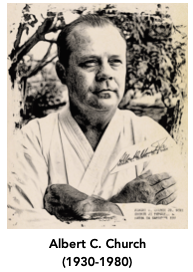 Good recognized that karate was in a disorganized state at this time, particularly regarding Dan grade belt ranking. He had witnessed Russell’s skills and unique martial perspective, and realized if Russell was to progress legitimately he would need to have his system recognized and approved by a highly regarded source. Good’s connection to Sacharnowski proved instrumental in getting Church’s organization to recognize Russell’s Isshin Kempo. Albert Church’s association with Rod Sacharnowski would only add more weight to his authorization of Russell’s sokeship.
Good recognized that karate was in a disorganized state at this time, particularly regarding Dan grade belt ranking. He had witnessed Russell’s skills and unique martial perspective, and realized if Russell was to progress legitimately he would need to have his system recognized and approved by a highly regarded source. Good’s connection to Sacharnowski proved instrumental in getting Church’s organization to recognize Russell’s Isshin Kempo. Albert Church’s association with Rod Sacharnowski would only add more weight to his authorization of Russell’s sokeship.
Albert Church was an expert in a form of Daito Ryu Aikijujutsu from Kim Chi Kooh, a Korean who had inherited and ancient Chinese system. Kooh left his style to Church. Church then travelled to Japan where he won further recognitions while training with the Yokota family of Japan.
In his effort to keep the system alive and to honor Church and the Yokota family, Sacharnowski, founded Dai Yoshin-ryu, in 1997, a division of Juko-Kai International to retain what he learned in the original Yokota style. The ninjitsu master, Hatsumi, had also honored Dr. Sacharnowski and his accomplishments with a high-dan grading from the Bujinkan.
To the surprise of many of Russell’s early advanced students Russell kept his own martial studies with other masters private. In particular, was his personal training in the 1970’s with the noted Aikijitsu master, Edward Smith, of Hokushin Aiki Bujutsu, a senior student of master Katsumi Tanemura. Here is a brief correspondence Smith and I had back in 2007:
6/8/07
Edward Smith wrote:
Greetings,
It was great delight with which I read the article on Isshin Kempo and it’s founder William Scott Russell. [Smith is referring to a June 2007 issue in Black Belt Magazine article on Isshin Kempo]. He was a close friend and fellow budoka. Mr. Russell was everything that the article described and more. He was one of the few karateka to study our Aikijujutsu lineage through seminars with Tanemura Katsumi sensei. He had an amazing eye for detail and always had insightful questions. He introduced several key people to us through our seminars and we always enjoyed his company. It was great to see his teachings covered in such a wonderful manner.
If it were not for Russell sensei, I would not have developed a healthy respect of Okinawan martial arts as my focus has always been aikijujutsu and judo. I also would not have met my senior student Matt Henderson, also well known in Goju ryu circles. Mr. Henderson attended our events
with his original jujutsu teacher Mel Chaefee- a friend of Russell sensei. I’ll never forget the brown keikogi that Russell sensei showed me many years ago- a custom one I believe. He truly was a rebel with a beautiful spirit.
I just wanted to say hello and introduce myself to you as we shared a relationship with a true gentleman warrior.
I wish your organization the best and know that it is in good hands. Thank you for your time and attention.
Edward J. Smith
Koden Bugei Kyokai
Recently, senior IK godan, Jay Austin, found a rare, historically significant, video gem regarding Russell. Near the end of the video, Smith makes a startling revelation during a promotional ceremony about William Scott Russell.
Smith’s comments speak to the depth and passion Russell had for the martial arts and his continuing search for knowledge. Russell’s other influential teachers, that we know of, were Danny Man Sophman (boxing), Robert Murphy (Isshin Shorinjiryu Okinawa Te), William Chung (Hung Gar), Gin Foon Mark (Southern Praying Mantis), and the above-mentioned, Edward Smith.
Regardless of the controversy surrounding Russell’s ranking at the time, he made a significant contribution to the U.S. martial community and those of us who continue to carry the legacy of Isshin Kempo into the future.
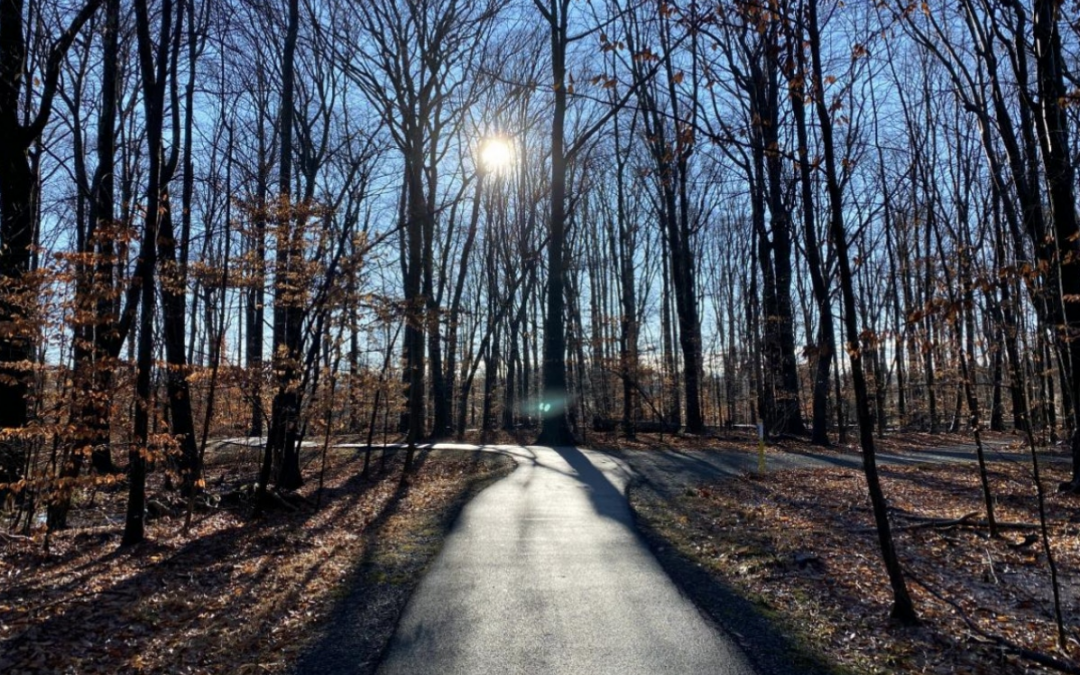
Martial Life In The Time of Covid: The Road Ahead
Hoping all of you are well in this roiling, restless world.
As you can imagine, the impact of the lockdown to lessen the spread of the Corona virus has had significant effect on martial arts worldwide. Similar to the financial crisis of 2008, we are going to see a large number of schools permanently shuttered. Particularly hard hit have been those dojo stressing, contact; Judo, Jujitsu, Aikido, MMA schools and clubs. Oddly, the Traditional schools got a small boost, with their kata work, which lends itself a bit more favorable to virtual instruction.
Click here to read/download PDF.
Personal Growth
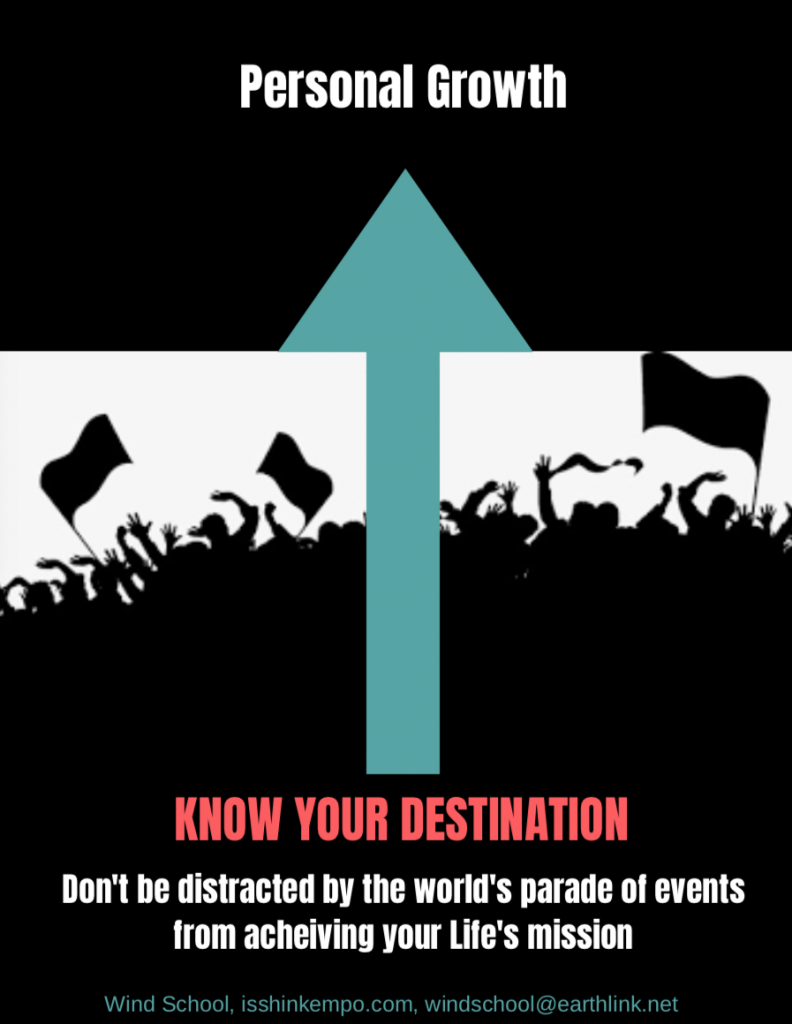
Karate-Do: Hierarchy of Training Mindset
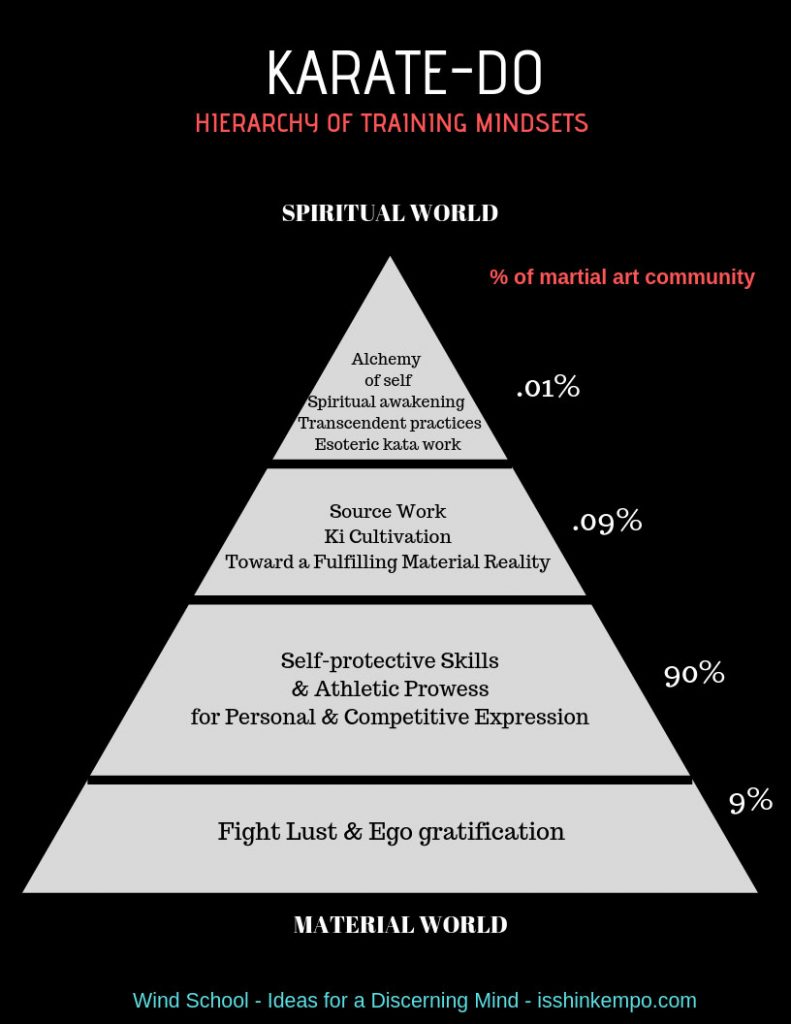
Out Of Earth’s Temple, Into The Fire!
Generating creative sparks in 2019
Welcome to our new website, a little sleeker and more tech savvy.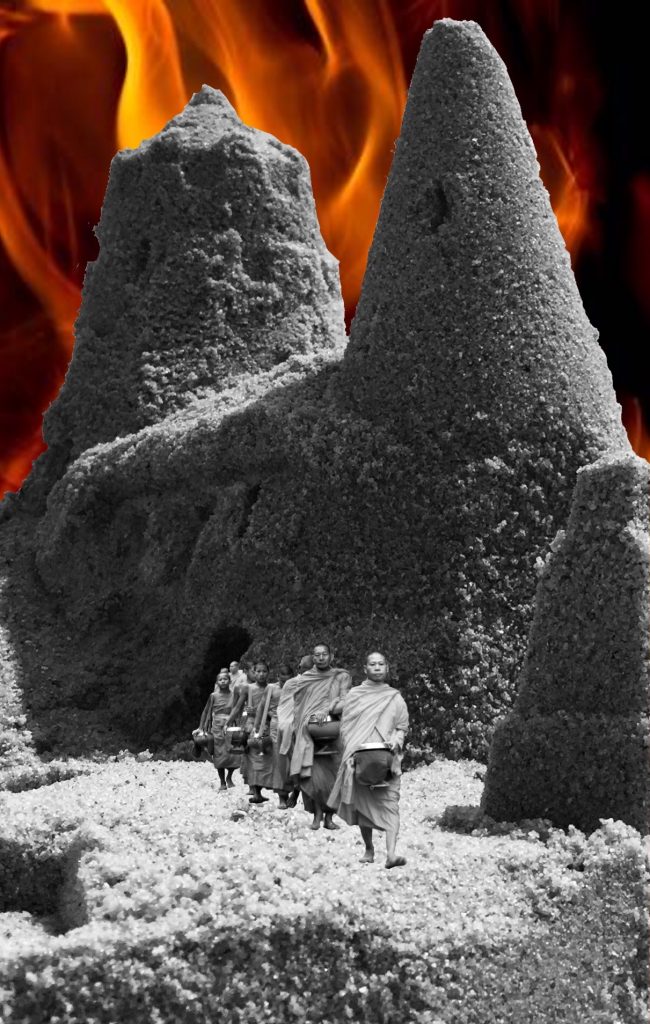
Never before do we need surefootedness in our individual journeys as we navigate into a volatile future, promising as long as we stay positive. The martial arts have provided generations of souls vitality, safety, mindfulness and meaning.
At the Wind School we perpetuate a whole-health philosophy. Since its founding, our School has offered thousands of students a spiritually-grounded Dojo, a Way Place, as a sanctuary, and a learning environment for vital living, personal protection, and a means to evolve into wholeness through the lens of Traditional Okinawan Karate-Do and Asian Mindfulness practices.
Exciting Events On The Horizon
I’ve been selected to appear alongside some of the top instructors in the U.S. discussing the merits of Traditional Karate training in a new book being written by Scottish author, Gary Quinn. (Release date not yet determined)
Whistlekick Martial Arts Radio will interview me on May 21, 2019. Whistlekick is one of the most listened to martial art podcasts in the U.S. Karate legends, Super Foot Bill Wallace, Fumio Demura and other greats have been interviewed on this weekly platform.
Hayashi’s interview on Whistlekick Radio will debut in early July, 2019 and can be accessed any time from that point onward at https://www.whistlekickmartialartsradio.com/
Don’t miss my latest article on NEIHANCHI, Okinawan’s Essential karate kata in the Media section. Long considered one of the most vital forms to come out of Okinawa, Neihanchi is a powerhouse kata filled with internal lessons and practical, tactical self-defense solutions, unrivaled by most other kata.
I hope to film a Training Video for Masters Magazine on Okinawan Neihanchi Kiko later this year. My ongoing research into kata is establishing me as an expert on Internal Okinawan karate kata development. It’s been an exciting study, which has pulled curious, dan-ranked martial artists from around the U.S. into a dialog.
I also hope to break ground soon on a new book about Karate KIKO. As many know this is a personal passion of mine. This project is to be also complimented by an online teaching course on Internal Karate with a projected completion in 2021.
It is my desire to continue to research, present, and preserve the best of the martial traditions for those looking for guidance, grounding, an athletic outlet, personal safety and enhanced vitality.
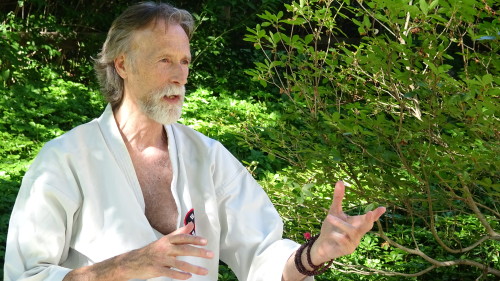
Piercing Cloud’s Eye
I practice karate as a form of yoga. This was not at all my focus when I was a teenager. And I suspect not many people would even understand what it means to practice a martial discipline in this manner.
So I’d like to clarify my statement.
The essence of yoga is a path back to the source of Self. It’s the search for authentic nature. It’s not about becoming more flexible. The essence of karate is transcendence of human conflict(s), learning to quell both inner and outer rebellion. It’s not about ultimate fighting. Its about ultimate peace.
Better flexibility or agile fighting skills have their place but they were always considered lesser talents when you were not being confronted by a hostile adversary or an inability to perform a task requiring looser muscles.
Hype about fighting. Hype about flexibility has distorted both the Karate and Yogic arts. But Western culture loves hype about everything. We live in a hyped-up culture today. It’s even hard to hear the real teachers over the din of the false ones because there is so much empty chatter out there.
It’s an illusion that you are going to grow fast, mature fast, succeed quickly—or do it all by yourself. That’s for a very rare few.
Life itself is an art and disciplines like yoga and the martial arts are there to aid us in our journey if used properly. However, the mainstream has lost its way in regard to these arts. More and more arts are being used for self aggrandizement. And many arts are becoming superficialized, watered down, even degraded.
The reason for the decline is that most people are pursuing lopsided goals. There is very little real or meaningful spiritual cultivation taking place in mainstream martial and yogic communities. This is what distorts our goals. Everyone’s in a rush to gratify themselves. Get that certification, get that belt. Get, get, hurry up and get important.
Look for the grounded paths, the clear-minded ways. They are out there. Choose your disciplines and teachers carefully. They are always calling the seekers.
Sit down and think about what really matters in life. That is when you will see the deep arts loom into view.
